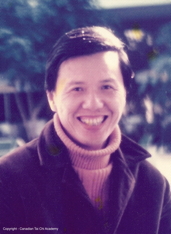Note: Content courtesy of CTCA. All rights reserved.

To understand the internal arts taught by Moy Lin Shin, it is helpful to look at his teachers and the influences he worked with, those he studied and practised with, as well as those who came before him in this “style”.
While Mr. Moy was alive, there was little or no reference to the legacy and tradition of his style. And why would there be? He was a living legacy of the tradition. While some say he simply “tweaked” the Yang style to make it his own, or his style of tai chi is not “real tai chi”, his lineage and references noted here reveal something completely different. 1
There is a rich heritage of form, from Wu Yi Hui, down through Leung Tse Pang to Moy Lin Shin and others. Each one appears to have “tweaked” the form subtly, perhaps to enhance the style, reflecting their previous expertise and personal learning gained through years of practice. These names share pre-eminent reputations as leaders in their discipline, validated through historical record, word of mouth, demonstrations and push hands competitions, a “marker” for quality in past times.
Mr. Moy was not solely interested in internal arts we typically associate (tai chi, lokhup, tsingyi, pa kua). Mr. Moy was a Taoist monk and co-founder of a temple in Hong Kong that studied the three religions of Taoism, Buddhism, and Confucianism. Meditation was a vital element of his practice. In fact, he indicated one’s progress in tai chi would always be limited without the inclusion of meditation in daily practice. The stillness of meditation gained might then transfer to develop a balanced state in movement and in stillness.

To further understand the principles Mr. Moy incorporated in his teaching we should also be aware of the predominant element in his personal practice, an active (as opposed to stationary) form of chi kung.
Mr. Moy said he had six teachers in his life. Only the last two were really influential. This would include Leung Tse Pang, his tai chi and Lok Hup teacher (for which he dedicated the Gei Pang Lok Hup Academy in 1989) and his lesser known chi kung teacher, Mr. Yeung.
This chi kung is a free-form active movement, directed, when initiated, from internal movement that spontaneously drives external movements, all designed to open and work with energy in the body.
With Mr. Moy’s death in 1998, we are presented with a challenge which previously we need not consider, how to sustain and develop his teaching while staying true to the principles that he taught? One way is to review and understand the influences from his past.
1 The references noted here are only one branch of the lineage. For further details and to see other similar examples begin from a web search engine and the lineage tree is quite wide and diverse in style.
The Foundation: Wu Hui Yi (Wu Yik Fan)2 1887-1958

Wu Hui Yi was actually the first person to teach Lok Hup to the general public, outside the traditional closed-door schools in China who restricted access to the teaching. According to the History of Chinese Martial Arts, many of Wu’s students were already experienced martial artists who took what they learned and merged it with their own knowledge.

In Figure 1 (sorry for grainy picture), note the remarkable symmetry between Wu’s postures and those that we see in pictures and video of Moy Lin Shin. (Link)

In Figure 2, a side view, again note the attention to the basic principles we study as the foundation for Moy’s tai chi. Keep in mind Wu was one of the top soft-style martial artists in China at the time. (Link)
These examples illustrate the foundation for the form Mr. Moy brought to Canada in 1970, a foundation from one of the premier internal martial artists in China.
